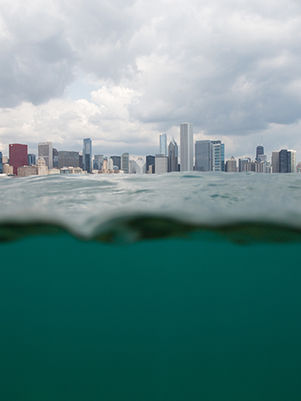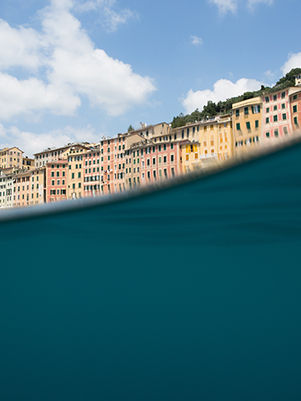Korean-photographer Ha Eul received his architecture degree from Ulsan University in 1992. He then spent close to twenty years photographing buildings in Korea, in particular for the magazine The Gong Gan. In 2011, he began the series called Amphibious Eye, recording city sites and famous edifices in works that record the images in compositions half given to sea water and half given to the architecture he is capturing. The show on view at Art Mora, a lively and independent space close to New York City, offered a selection from the sequence, proving that Ha Eul is more than a photographer of note, being an artist who challenges the eye and mind of his audience; and, additionally, that it is possible for demanding work to appear outside the downtown district of our metropolis. Ha Eul’s photos are exquisite records of buildings made under often taxing circumstances, but what first meets the eye is his merger of water and building, in an imagery in which the fluidity of the former both supports and, to a degree, diminishes the solidity of the manmade. We know that water, over centuries, is capable of eroding the hardest of stone, so on some level, however unknowing, it may be that Ha Eul’s work intimates the ephemerality of what we build. On another level, the water, whose colors variously range in the pictures from cobalt blue to sea green, exists not as a lens through which to see the architecture, which always sits on top (the water offers no view), but as a substance in its own right, almost always visually impenetrable in his work. As a result, two kinds of solids are being offered in the same composition. One, though, is entirely fluid and, by implication, constantly changing, while the other is meant to stay stable and centered for more than some time.
The implications of the work are easily read as metaphysical--one point of view sees our visual given as entirely in flux, even if the photo captures and stills that flux. In the other point of view, we think of convention over time: history in the form of architecture, which is experienced as motionless and solid over decades, often longer. Ha Eul emphasizes this by splitting the image in half horizontally, shooting up from within the water toward the buildings he is choosing to emphasize. This is double vision, both literally and metaphorically. It means that the artist is unwilling to give up, quite literally, a complex point of view. The photographs are sometimes a record of contemporary buildings, sometimes of very old ones, such as the cathedral Mont-Saint-Michel in Normandy. If it is true--and both contemporary physics and the venerable practice of Buddhism agree it is true--that the world is in constant flux, we must acknowledge Ha Eul’s art as a recognition of that ongoing, continuous movement. At the same time, we inevitably erect a culture that solidifies the flux for a moment, so that we can pay attention to our achievements, however momentary they may be. In absolute, the balance may be unequal--at some point the earth we live on will cease, and our efforts will yield to silence. But that does not mean, at least for now, that art cannot strengthen our fragile position, bookended as we are by suffering and mortality.
It is not that Ha Eul’s art is so overtly given to philosophical rumination--he is a very good artist but not a professional thinker. Instead, it is the remarkable intuition he offers in his work, in which the notion of fleeting awareness hovers over his enterprise, from not so far away. How long does it take to shoot a photograph? Usually, only a moment, or only a fraction of one. But the image (if printed on archival paper) endures. We must remember how Ha Eul is treading the water himself as he photographs, so that he is also immersed in a state of instability, demonstrating in actual terms the restless position of the artist, compelled as he is to construct something hopefully lasting from his unsteady point of view. Good art always imposes a stop on the troubling impermanence of experience; it has to do that because form is a kind of time made motionless (but is it true as well that process art, a relatively new phenomenon, chooses not to see creativity in this fashion). Even so, we are all in the grips of a moment-to-moment perception of what is essentially a flux, and because most art, even now, is made with the awareness of stopped time, we can only point out how this instant, rendered concrete by the image, can stand for the recognition of the world as it is to our eyes and thoughts--as a place more than a transition. Thus, Ha Eul’s photos are a point of view rather than a narrative indicating, as film does, events over time. He teaches us, in avant-garde fashion, that good recent art doesn’t have much to stand on, even if it attempts to create a place where standing is comfortable. In his case, this means, exactly, that the image must originate in the continuous activity of water.
Let’s look at the photos and see how Ha Eul’s intuitive dichotomies play out. Normandy_01 (2011) shows a distant view of Mont-St.-Michel, the great abbey and cathedral built over a five-hundred-year period, from the 11th to the 16th century. We are now firmly ensconced in the beginnings of the 21st century, so we are left with a thousand-year history. The view looks up from a slightly undulating curve of brown-green water, with a quick view of the surface, itself slightly rippling in its effect. The watery view emphasizes the distant grandeur of the cathedral, whose spire rises skyward in sublime heights. The blue of the sky is mirrored by the slightly darker blue of the water, so that the building appears to be surrounded by cerulean spaces and densities. It is true enough that Mt.-St.-Michel is one of the great monuments of medieval Christianity, and this very recent picture attempts to place it, quite precisely, at the interstice of sky and sea--consequences both of natural processes that are far older than our comprehension of them. There are differing specificities of date at play here, and our recognition of them deepens our appreciation of the image. In another work, though, we see much more recent buildings: Chicago_01 (2014), a horizontal triptych, with a thick swathe of gray, off-white clouds on top, a thin ribbon of city buildings in the middle, and, in the composition’s bottom half, the ocean topped by foam. The photo is a very up to date one of one of America’s major cities. It is about contemporaneity--this despite the ancient frame of clouds and sea. The building’s mostly silver facades echo what looms above them and contrast with what is below. They are manmade and thus cultural, asserting the historical timeliness of what people do. But they are not permanent, and so, despite their solid materials, they are doomed to ruin. Since the end of the earth is also inevitable, we cannot say that natural phenomena, as we know them, will continue either. But maybe that is what these pictures are suggesting.
The Amalfi Coast (2014) image is dominated by the lower half of the image, taken up with dark-blue seawater that curves slightly upward to the right. Windowed, six-story buildings, mostly tan and pale pink in hue, crowd against each other, looking slightly wobbly given the distortion of the camera’s point of view. As the hill rises toward the top of the image, the buildings diminish in number and yield to the dark green of trees. Cumulus clouds appear in the upper-left corner of the picture. This image comes from a fifty-kilometer piece of coastline on the Sorrentine Peninsula in southern Italy; it is a favored destination for tourists. The image itself, though, is inevitably unsteady--are we meant to think once more that we are facing the eventual (or imminent) collapse of the architecture? Our speculations notwithstanding, it makes sense that Ha Eul is moving always in the direction of impermanence, in which what we make is shadowed from the start by its ultimate, inevitable ruin. In another photo, New York_15 (2014), we come up against a small shot of the copper-green Statue of Liberty, supported by a thick band of dark water. The diminutive size of the American icon of freedom shows us that, at least here, Ha Eul may be cutting the American dream down to size. Again, we can only speculate on the metaphysical or political meanings of what he portrays, although it is fair to say that he is an artist whose natural and social implication likely extend far beyond what he depicts.
The final two images to be discussed continue the artist’s general bias. Amphibious Project London (2011) consists of a two-thirds view of the twin London Bridge towers and, on the left, the curved steel support rising to the upper left of one of the tower buildings (a small part of the right support can be seen on the right of the photo). The dark blue water filling the lower half of the composition has a couple of ripples and curves upward on either side, while the towers are backed by thick clouds seems immediately above the water and, above them, an open sky. The Tower Bridge, built in the late 1800s, is a major visitor attraction. The other image, the last to be described, is the bird’s nest stadium in Beijing; the water beneath it is murky, turgid with plant life, while trees flank the steel structure on the left. The sky holds a single major cloud found above the trees. Opened in 2008 for the Olympics, the stadium maintains an important visible presence in the city. It reiterates the merger of the manmade and nature in one structure--Ha Eul’s plan from the start. The repetitive structure of the photos mentioned in this review may weaken a bit the ongoing effect of Ha Eul’s art, but the point he is making is strong enough to support restatement. The artist is attempting to illustrate a major point, namely, the mutual co-existence of culture and creation--at least for now! No matter how long this concomitant existence of the manufactured and the given lasts, it cannot be called endless. This is not so much a problem as it is an inevitability. Fine art has often paid attention to these joined circumstances, but not always--sometimes emphasizing culture and sometimes emphasizing the world. Ha Eul’s achievement here is to have produced a body of work that addresses the simultaneity of what we do and what surrounds us (but not produced by us) in images notable for their startling attraction. The metaphysics, though, are left to his audience.
Jonathan Goodman, September 19, 2019






